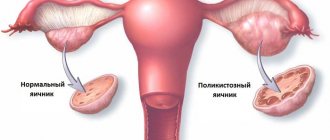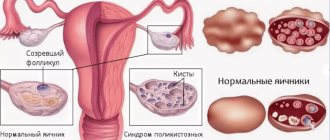pharmachologic effect
The main active ingredient in Duphaston is an artificial substitute for progesterone, a deficiency of which causes reproductive system disorders and other changes in a woman’s body.
Thanks to the use of the product, it is possible to normalize the amount of progesterone, which allows you to achieve the following changes:
- normalize the cyclicity of menstruation,
- reduce pain during menstrual periods,
- increase the chance of a natural pregnancy,
- reduce estrogen concentrations.
Thus, taking the drug allows you to normalize hormonal levels, disturbances of which are fraught with malignant tumor processes and other pathologies. In addition, such treatment makes it possible to eliminate the consequences of hormonal disorders, such as endometriosis, bleeding, hyperplasia, etc.
Pregnancy on duphaston with PCOS
PCOS and duphaston are inseparable concepts when it comes to infertility treatment and proven insufficiency of the corpus luteum phase. Without enough progesterone in the mucous layer of the uterus - the endometrium. Sufficient secretory transformations, which are so necessary for the normal implantation of a fertilized egg, will not occur, and if implantation does occur, then the reduced level of this hormone can provoke a threat of miscarriage, and in some cases, spontaneous abortion. Pregnancy with PCOS is continued on duphaston until the placenta of the intrauterine developing child begins to produce progesterone in sufficient quantities. If a woman has achieved the desired pregnancy while taking duphaston, then in no case should you stop taking it after it occurs at the moment when the pregnancy test flashes. Only after a thorough examination and consultation with your obstetrician-gynecologist can you begin a gradual reduction in the dose of the drug. The duration of such actions is also prescribed by the attending physician.
Contraindications
Duphaston therapy for polycystic disease is far from standard treatment methods, which are prescribed by the doctor exclusively on an individual basis.
Tablets, like any other pharmacological agent, have a number of contraindications, namely:
- individual intolerance and allergic reactions to the components of the drug,
- high threshold for destruction of red blood cells,
- frequently recurring headaches,
- liver ailments,
- excessive breast sensitivity,
- hives,
- periodic swelling.
Attention! The drug is contraindicated during breastfeeding. Also, use is unacceptable for patients who have previously become pregnant, which was accompanied by an allergic reaction. Otherwise, taking it may cause Quincke's edema.
Side effects
Treatment of ovarian cysts with the drug can cause a number of side effects. You should be aware of this. If the condition worsens, another drug may be prescribed. Doctors once again warn that self-medication is prohibited, otherwise, a drug that is beneficial can cause harm.
- The reaction from the central nervous system manifests itself in the appearance of migraines and headache attacks.
- Immune system hypersensitivity may develop.
- There are known cases of hemolytic anemia.
- Allergic skin reactions in the form of urticaria, rash, and itching cannot be ruled out. Quincke's edema is observed in very rare cases.
- Sensitivity of the mammary glands.
- Uterine bleeding.
- Weakness and jaundice are signs of liver failure.
Chances of getting pregnant after therapy
Using the drug for polycystic disease increases the likelihood of pregnancy. This is because progesterone-containing products do everything possible to maximally prepare the endometrium for egg implantation.
It is for this reason that gynecologists recommend Duphaston treatment to girls who are planning a pregnancy.
Also, the drug can be prescribed by a doctor after pregnancy. This is done to ensure that taking the pills accompanies the full development of the fetus and reduces the likelihood of miscarriage due to hormonal imbalance.
Treatment of polycystic ovary syndrome with Duphaston
The features of treatment and all its complexity for polycystic ovary syndrome lie in the many problems and dysfunctions that occur against the background of the disease.
Due to metabolic disorders, patients with polycystic ovary syndrome experience disruptions or complete absence of menstruation, which can lead to infertility. It is the failure to ovulate and the impossibility of natural pregnancy that is considered the main problem.
To provoke the onset of ovulation, various medications containing natural progesterone or its substitutes are used today. Duphaston belongs to this group of drugs.
For the treatment of patients with polycystic ovary syndrome, the drug is prescribed from days 16 to 25 of the cycle in order to simulate phase 2 and make possible the onset of secretory transformation of the endometrium. So, after 10 days of treatment with the drug, the endometrium is completely rejected, which leads to menstrual-like discharge.
Of course, taking Duphaston can improve the cyclicity of menstruation. But, unfortunately, such drugs cannot stimulate the onset of ovulation, so pregnancy does not occur. In simple terms, progesterone-based products do not help cure polycystic ovary syndrome.
To eliminate the consequences of polycystic disease in the form of delayed menstruation, Duphaston is taken 1 tablet 1 time per day, regardless of meals.
Use of the drug Duphaston in the treatment of endometriosis and fibroids Thrush with bloody discharge (mixed with blood) How to delay menstruation - the use of oral contraceptives Horny uterus in women - what is it
During menstruation
If a girl is diagnosed with polycystic ovary syndrome, and there are no additional ailments (for example, obesity), the drug is taken from the 14th to the 27th day of the cycle, 1 tablet. This is necessary in order to compensate for the deficiency of progesterone in the 2nd half of the cycle, which is not enough for the onset of menstruation.
Unfortunately, Duphaston therapy to normalize menstruation is not a solution. This is only a temporary measure. Many patients claim that after finishing taking the pills, their periods become irregular again.
During pregnancy
Duphaston and its analogues help prepare the endometrium for egg implantation. In patients even with rare but independent periods, natural pregnancy can occur.
Duphaston tablets help maintain pregnancy, reduce the risk of pregnancy failure, to which patients with polycystic disease are very prone, as well as premature onset of labor.
For pregnant patients with polycystic ovary syndrome, the drug is prescribed from the beginning of pregnancy until the 16th week, until the placenta is fully formed and can independently synthesize progesterone.
How to take medicine correctly
The standard preparation of the endometrium for polycystic ovary syndrome with duphaston is its administration for three to six cycles according to the scheme: the start of administration is scheduled for the 11th day of the cycle, and the end - for the 25th day. This method of administration is intended for women who have a cycle lasting 28 calendar days.
The standard dose is considered to be 20 milligrams per day both before and after pregnancy. Cancellation, as already mentioned, is carried out only by the attending physician if there is evidence for this. However, I would like to clarify once again that these are standards that may change depending on the clinical situation.
In some cases, a woman who does not receive hormonal therapy either before or after pregnancy is in dire need of progesterone medications. This occurs when there is a threat of miscarriage and low levels of progesterone. It is important to take into account the fact that it is advisable to prescribe an analysis to determine the level of progesterone in the blood only in the period from 16 to 22 weeks.
At other times, according to the latest data, the results of the progesterone test should not be used as a basis for prescribing maintenance therapy with progestogen drugs. Sometimes utrogestan, micronized progesterone, is prescribed as a progesterone component, depending on the obstetric and gynecological situation.
Each case, each woman with an obstetric-gynecological disease requires an individual approach to prescribing a set of clinical, laboratory, functional studies, drug therapy regimens, as well as the duration of taking a particular drug. As for Duphaston, the drug has a pronounced progestogenic effect, which is applicable in all cases of confirmed luteal phase deficiency, normalizes the ovarian-menstrual cycle, and prepares the endometrium for pregnancy for successful implantation.
You can take Duphaston only after your doctor has prescribed it. The regimen is developed individually, as is the required dosage for the treatment of pathology. Instructions for use are in each pack, but this does not indicate the possibility of independent selection and duration of treatment.
As a rule, the drug in the required dosage is prescribed from the 11th to the 25th day of the menstrual cycle. It is strictly forbidden to shift your schedule or skip pills. It is prohibited to stop taking the drug on your own; this may cause uterine bleeding. The use of a hormonal drug with the correct approach to treatment and compliance with all recommendations will be effective, otherwise it can cause complications.
Duphaston's analogues
Duphaston has many analogues; they differ in the amount of active ingredient and composition.
Dydrogestron is considered to be absolutely identical drugs.
Also an analogue is Utrozhestan - a Thai version, in the production of which natural ingredients are used, the collection of which was carried out from donors. This analogue has the least side effects.
There is also a Russian analogue on the pharmaceutical market - Progesterone. This product with a gestagen stimulates the production of the corpus luteum. Release of the drug in the form of injections.
Despite the similarity of the drugs, you should not self-medicate. The need to take Duphaston or its analogues is assessed by a gynecologist.
How to take duphaston for PCOS?
With polycystic ovary syndrome, due to an excess of fractions of male sex hormones, the entire ovarian-menstrual cycle fails, the ovulation process is disrupted in each cycle, and follicles that do not ovulate undergo partial atresia, leaving behind cystic cavities every month. These formations form the characteristic anatomical structure of the ovary, which ultrasound doctors are accustomed to seeing on the monitors of their devices.
Therefore, treatment with duphaston for PCOS is carried out both as monotherapy to correct the menstrual cycle in cases of proven progesterone deficiency, and in combination with an estrogenic component in the first phase. The regimen for using this drug may vary depending on the clinical situation and the doctor's view of this problem. Typically, treatment of PCOS with duphaston is prescribed from days 14-16 of the menstrual cycle to days 25-26. Then, after discontinuation of the drug, menstrual bleeding occurs, which is the first day of the new menstrual cycle. in it everything happens according to a pre-agreed pattern that was applied in the previous month.
Drugs prescribed in combination
Polycystic ovary syndrome is not a simple disease that rarely responds to the effects of conservative treatment methods. Therefore, Duphaston therapy alone is not enough; supplementation with homeopathic remedies and vitamin complexes is necessary.
So, an excellent addition to therapy could be:
- Aevit,
- Gerimaks,
- Remens,
- Gynekohel,
- Veroshpiron, etc.
It will be possible to achieve positive dynamics in the treatment of polycystic ovary syndrome with Duphaston only with an integrated approach, proper nutrition and physical activity.
Reviews from women
As the long-term practice of gynecologists shows, women's opinions about Duphaston are very different. Some claim that it was the pills that helped them heal, get pregnant and give birth to a healthy baby. Others, on the contrary, do not believe in the effectiveness of such treatment.
Lilia, 27 years old
Problems with menstruation began 3 years ago. But there was no time to visit a doctor and find the cause. A year ago, during a routine examination with a gynecologist, I heard a diagnosis of polycystic ovary syndrome. I completed a course of treatment with Duphaston, my periods were restored, they became less heavy and painful. Having stopped taking the pills, the situation has not changed, I feel great.
Anna, 33 years old
My husband and I tried to get pregnant for more than 5 years. But all attempts came to naught; once at 7 weeks a miscarriage occurred. On the recommendation of the gynecologist, I took a course of Duphaston, and already 4 months after treatment I saw 2 coveted stripes on the test. Until 14 weeks I took pills to avoid miscarriage. Today our son is 1 year and 3 months old.
Description of the drug
Duphaston is prescribed to many women for polycystic ovary syndrome due to its effectiveness. Each tablet contains 10 grams of dydrogesterone. This artificial hormone helps replace endogenous progesterone in women, which is missing or deficient. The body stops producing the hormone as a result of hormonal imbalance.
Despite the fact that duphaston is not included in the list of indications for polycystic disease, many gynecologists prescribe this drug to patients. This is due to the drug’s ability to regulate the monthly cycle, disruptions in which occur with polycystic disease. This medicine does not have the ability to normalize the cycle for all women. If the drug is ineffective, doctors prescribe utrozhestan.
Many doctors recommend taking duphaston to women who want to become pregnant after treatment. This drug helps stimulate egg maturation, which sometimes does not occur in patients with polycystic disease. Let's try to figure out why patients with polycystic disease cannot get pregnant.
Progesterone is a hormone that is responsible for the pregnancy process. It is involved in preparing the uterine endometrium for the meeting of a fertilized egg. During the first three months of pregnancy, the corpus luteum produces progesterone, which is necessary for the existence of the embryo. Starting from the fourth month of pregnancy, the placenta is responsible for the production of progesterone. Thus, the female body needs this hormone throughout the entire period of pregnancy.
The success of conception also depends on progesterone, since this hormone affects ovulation. Progesterone relaxes the uterine muscles, which prevent the implantation of the embryo. Therefore, it is necessary to cure hormone deficiency at the pregnancy planning stage. While carrying a baby, a woman needs to monitor the concentration of progesterone in the body to prevent the risk of losing the child. In order to compensate for the lack of hormones, drugs such as duphaston or utrozhestan were invented.
The medicine is available in the form of coated tablets. Excipients are lactose monohydrate, magnesium stearate and corn starch. The shell contains hypromellose, titanium dioxide and polyethylene glycol. The drug is packaged in 20 pieces in blisters, which are in cardboard boxes.
We recommend you learn: About Duphaston for multifollicular ovaries











